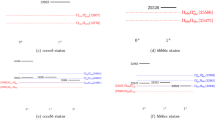Summary
The pion-hyperon interactions are considered in the light of a compound model in which a hyperon is taken to be a system of a nucleon plus a meson whose only role is to give the hyperon its observed symmetry properties. It is assumed that pions interact with the nucleon in a hyperon as if the nucleon were free, and that pions do not interact appreciably with the new meson. The pion interactions with the Λ and Σ which follow from this model are equivalent to the interactions of the elementary particle theory of Gell-Mann. The pion interactions with the Ξ are not unique without a further restriction on the model. As an example of this non-uniqueness, two different ΞN potentials are obtained, one of which is approximately the same as the ordinary nucleon-nucleon potential, while the other is much weaker at large distances.
Riassunto
Si esaminano le interazioni pione-iperone nel quadro di un modello composto nel quale un iperone si considera come un sistema di un nucleone più un mesone il cui solo compito è di conferire all’iperone le proprietà di simmetria osservate. Si assume che i pioni interagiscano col nucleone in un iperone come se il nucleone fosse libero, e che i pioni non interagiscano apprezzabilmente col nuovo mesone. Le interazioni dei pioni coi Λ e Σ che derivano da questo modello sono equivalenti alle interazioni della teoria delle particelle elementari di Gell-Mann. Le interazioni dei pioni con i Ξ non risultano univoche se non si impongono al modello ulteriori restrizioni. Come esempio di questa mancanza di univocità, si ottengono due potenziali ΞN, uno dei quali è approssimativamente uguale all’ordinario potenziale nucleone-nucleone, mentre l’altro è molto più debole alle grandi distanze.
Similar content being viewed by others
References
M. Goldhaber:Phys. Rev.,101, 433 (1956).
R. Christy:Proceedings, Seventh Annual Rochester Conference on High Energy Physics (Interscience, 1957).
W. Heisenberg andW. Pauli: unpublished manuscript.
M. Gell-Mann:Phys. Rev.,106, 1296 (1957).
D. Lichtenberg andM. Ross:Phys. Rev.,107, 1714 (1957).
See alsoJ. Schwinger:Annals of Physics,2, 407 (1957).
The neglect of the mass difference between Ξ and N means neglecting effects of the order of (M Ξ-M N)/M Ξ or 30%. The error due to the neglect of K-mesons depends on the unknown K coupling constants. For a brief discussion of some effects due to K-mesons and baryon mass differences, seeD. Lichtenberg andM. Ross:Proceedings, Padua-Venice Conference on Mesons and Recently Discovered Particles (1957) andPhys. Rev.,109, 2163 (1957).
As one example, seeK. Brueckner andK. Watson:Phys. Rev.,92, 1023 (1953).
Author information
Authors and Affiliations
Rights and permissions
About this article
Cite this article
Lichtenberg, D.B., Ross, M. On a compound model of the pion-hyperon interactions. Nuovo Cim 10, 104–110 (1958). https://doi.org/10.1007/BF02859609
Received:
Published:
Issue Date:
DOI: https://doi.org/10.1007/BF02859609



